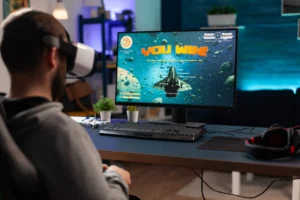
In the realm of gaming, where virtual worlds rival reality’s intricacy, Quality Assurance (QA) is undergoing a transformation. Game QA faces challenges often overshadowed by design and development aspects, yet QA plays a pivotal role in shaping gaming’s future.
Moving beyond traditional bug hunting, QA’s integration in delivering immersive, bug-free experiences helps games to meet gamers’ high expectations. Game developers, QA professionals and enthusiasts can leverage QA strategically, not just as a necessity.
The Growing Complexity of Game QA Challenges
Game QA faces a complex web of unprecedented scale and complexity challenges. The increasing sophistication in video games, with expansive worlds and intricate mechanics, renders traditional QA methods obsolete for scrutinizing diverse content and scenarios.
Video games must offer seamless and immersive experiences. Players are not just customers, but enthusiasts expecting virtual perfection. Any glitches or bugs can break immersion, causing frustration. Thorough quality assurance (QA) testing is crucial to meet high player expectations.
New technologies like virtual reality (VR) and augmented reality (AR) add complexity. QA teams need technical know-how to ensure flawless execution in these new dimensions. Understanding how they impact player interaction is also important.
Agile and DevOps development demands integrated, responsive QA. Testing can’t be the last step. QA must be ongoing, evolving with the game to find and fix issues in real-time.
The global gaming market means games need to engage diverse cultures. QA must consider not just technical aspects, but cultural contexts for universal accessibility.
Navigating the Labyrinth: Market-Wide Solutions for Game QA Challenges

Tackling game QA’s intricate challenges demands an approach that goes beyond regular testing methods. The industry-wide solution begins with integrating advanced tech in the QA process. Automated testing tools using AI and machine learning are becoming vital. These tools can quickly spot patterns, predict potential issues and perform repetitive tasks with higher accuracy and efficiency than human testers alone. They excel at handling the vast, repetitive tasks required for testing complex video game environments.
Another key solution is adopting a more comprehensive, lifecycle-integrated QA approach. QA teams must be involved from the earliest development stages, ensuring testing is fundamental, not an afterthought. This approach allows early issue detection, reducing time and costs of fixing problems later.
Embracing a global QA perspective is also crucial. With gaming’s vast reach, understanding diverse cultural nuances and preferences is essential. QA teams must include cultural experts and leverage localization testing to ensure games are culturally appropriate and resonate with players across regions.
Cloud testing tools have also become popular. They allow games to be tested across different devices and setups, ensuring they work well on various platforms. This matters since games launch on consoles, phones and more platforms.
Engaging beta testers is valuable, too. Real players can spot issues that developers may miss. Gauging players’ reactions also helps to refine the overall experience.
GlobalStep’s Tailored Solution: Tomorrow’s QA Today
At GlobalStep, we don’t just use standard QA methods. Our solutions are custom fit to each game’s unique needs. Every title requires special attention, so one-size-fits-all won’t work.
We apply AI and machine learning in novel ways, using predictive analytics to identify potential problems before they arise. This proactive approach maintains game quality while ensuring a smooth user experience.
Our quality testing is a key part of the video game creation process. We closely work with developers to give real-time feedback and fix issues. This makes sure the final product meets both technical standards and the creative vision.
Cultural understanding is important to our global testing approach. Our diverse teams bring knowledge of different markets and cultures. We make sure games are not just technically good, but also engaging and relevant for players worldwide.
We use cloud-based testing to simulate many real scenarios. This optimizes video game performance across various devices and platforms, delivering a consistent high-quality experience.
We also involve the player community in testing, gathering feedback from beta testers and early access. This input is key to fine-tuning the game and exceeding player expectations.
At GlobalStep, our approach blends advanced tech, integrated processes, global insights and community involvement. Our tailored testing perfects gaming experiences globally.
Empower Your Quality Assurance: Elevate with GlobalStep
As gaming evolves, adopting innovative QA solutions is vital. Game developers, publishers and QA experts must embrace new paradigms to ensure your games exceed quality standards and player expectations.
The journey to exceptional QA is challenging yet crucial. GlobalStep offers tailored solutions to address unique game challenges. Our advanced tech, integrated processes, global insights and community strategies are designed to take your game from good to great.
Shaping the Future: Game QA Evolution’s Impact
Game QA is profoundly transforming, redefining its industry role. While challenges like modern game complexity and diverse global players exist, opportunities arise to innovate, improve and excel.
GlobalStep leads the game QA evolution, guiding you through this transformative journey. Our dedication transcends industry standards, so you gain more than a service provider – you’ll have a strategist, an innovator and a partner in game QA excellence.
Together, let’s sculpt the future of game QA, crafting gaming experiences that resonate deeply, cherished for their quality. Request a meeting with GlobalStep to learn more about the boundless possibilities of game QA.





